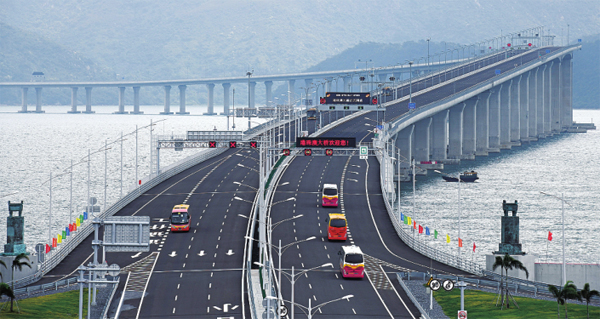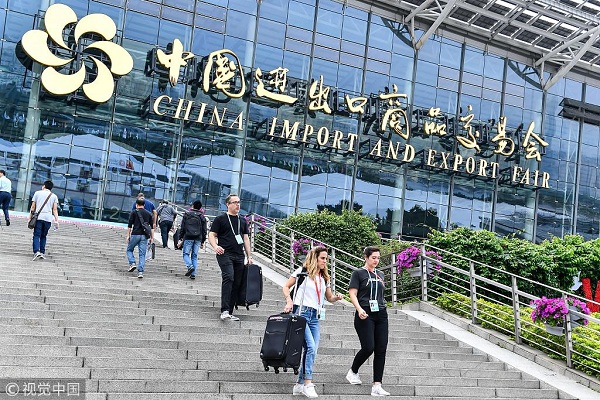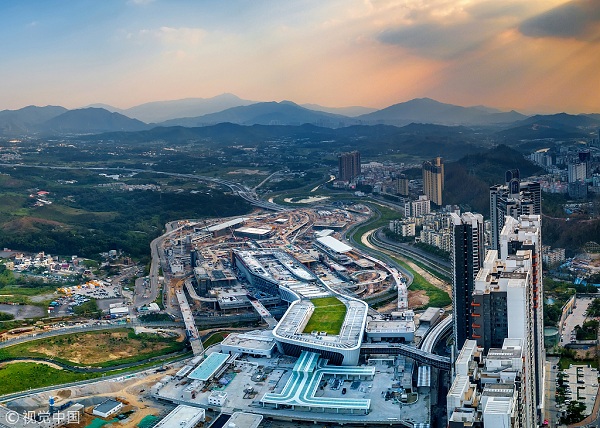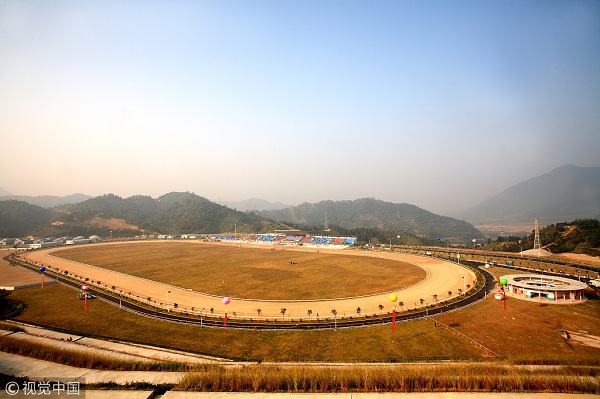Guangdong optimizes business environment at ports


Vehicles travel on the Hong Kong-Zhuhai-Macao Bridge. [Photo/southcn.com]
The People's Government of Guangdong Province recently released a document to further optimize the business environment at the province's ports. A series of preferential measures to facilitate cross-border trade and promote stable and sound development of foreign trade are included in the document.
Standardize and reduce port charges
1. List of port charging items will be standardized and updated on the Guangdong international trade "single window" platform (http://www.singlewindow.gd.cn/). "Single window" is an online platform, enabling international traders to submit regulatory documents at a single location and/or single entity.
2. Inspections and guidance on port charges will be reinforced to put an end to random charges.
3. Supervision on approval of new charging items will be strengthened.
4. Drawing on experiences in Nansha district in Guangzhou, the capital of Guangdong province, the application scope for foreign trade firms will be expanded where such firms will be exempted hoisting and warehousing fees when satisfying regulated requirements.
5. Small ships from or to Hong Kong and Macao will be exempted from certain service fees such as internet maintenance fees and file transfer fees. By the end of June 2019, firms using small ships for transport will be able to declare goods free of charge via the "single window" platform.
6. Port cargo facility fees, port security fees, and pilotage and mooring fees will be reduced or eliminated through a series of measures, including applying for national financial support.
7. Port operational fees such as cargo storage fees will be lowered.
8. On the basis of deepening integration of customs clearance with inspection and quarantine, related service fees will also be reduced. Consulting fees for the inspection and quarantine of postal and express packages will be eliminated.
9. A communication mechanism will be launched between governmental departments and shipping companies and agencies for the benefit of foreign trade firms. Foreign trade firms will be informed of policies and measures on reducing port charges.
Improve customs clearance services
10. Work time limits in some major ports, including Port of Guangzhou, Port of Shenzhen and Port of Zhuhai, will be set. By the end of 2019, work time limits for foreign trade container ports across the province will be fully disclosed.
11. Customs clearance procedures, time limits and required documents will be publicized at every port and on relevant websites.
12. The service hotlines of single window platforms (95198) and the customs authority (12360) are connected to deal with consulting and complaints from firms.
13. Smart supervision and regulation will be implemented during the customs clearance process to realize 24-hour services.
14. Customs clearance procedures for international exhibition trade concerning the annual China Import and Export Fair and China High-tech Fair will be simplified.

The 124th China Import and Export Fair closes in Guangzhou Nov 4, 2018, with cumulative export turnover of 206.94 billion yuan ($29.86 billion). [Photo/VCG]
15. Multimodal transport will be developed in the province. One-stop aviation-land transport at Hong Kong International Airport and Nansha Bonded Zone will be launched with the exception of cargo requiring inspection and quarantine. Service rules and regulations for multimodal transport will also be explored among government departments, with the aim to provide seamless supervision and regulation services during the process.
16. An evaluation mechanism for port business environments will be established. In accordance with the World Bank's business environment evaluation indicators, and third-party organizations will be entrusted to assess the overall situation of ports across the province. A normalized tracking and monitoring mechanism will also be promoted.
Reinforce building of international trade "single window" platform
17. The overall planning and construction of a digital platform for ports across the province will be coordinated and promoted. Data and information on the Shenzhen "single window" platform will be moved to the Guangdong digital platform. Data safety management on the standardized "single window" platform will be strengthened.
18. All businesses will be able to deal on the standardized "single window" platform. By the end of 2020, the ratio of handling major businesses (declaration of import/export goods, manifests, and means of transport) on the "single window" platform should be up to 100 percent.
19. Based on the "single-window" platform, an evaluation system for clearance efficiency will be promoted among qualified water ports (terminals) across the province. The system will be applied at aviation and land ports by the end of 2019.
20. By fully utilizing science and technology, the construction and upgrading of smart infrastructure and facilities at ports will be pushed, and digitalization of logistics information will be enhanced. Based on the "single window" platform, an integrated digital platform will be piloted in Guangzhou, Shantou and Jiangmen by the end of 2019, realizing one-stop formalities going through online.
Reform management model for customs clearance at ports involved in the Guangdong-Hong Kong-Macao Greater Bay Area
21. Construction on the Port of Liantang in Shenzhen and the Port of Qingmao in Zhuhai, as well as the upgrading of the old Huanggang and Shatoujiao ports in Shenzhen and Gongbei, Hengqin, and Jiuzhou ports in Zhuhai will be promoted in line with the development position of ports in the Greater Bay Area, so as to improve infrastructure interconnections and enhance capacity for customs clearance.

A drone's view of Liantang Port in Shenzhen which is under construction [Photo/VCG]
22. By the end of 2019, the inspection mechanism at the Port of Zhuhai for the Hong Kong-Zhuhai-Macao Bridge will be improved based on the pilot testing results. New and convenient customs clearance models will be carried out at Qingmao, Liantang, and Hengqin Port. In addition, passengers' information will be shared between immigration inspection and customs authorities to improve efficiency.
23. The "water bus" customs clearance model will be promoted in the area. The model was created by Huangpu Customs, one of the seven regional customs in Guangdong province, and has been implemented in Shatian port in Dongguan and Shekou port in Shenzhen. This model breaks the port operation time limits, enabling cross-border goods to be cleared at any time.
24. By the end of 2019, the facilitation policy for Macao motor vehicles entering and exiting Hengqin will be improved with more supporting measures. Additional preferential measures will be formulated for the convenience of motor vehicles from or to Maocao and Hong Kong via more ports in Guangdong.
25. By the end of 2019, based on the road transport declaration system on the standardized "single window" platform, a comprehensive online service platform for cross-border vehicle information management at the Greater Bay Area will be built to simplify vehicle approval and records procedures.
26. Pragmatic cooperation between the standardized Guangdong "single window" platform and the ones in Hong Kong and Macao will be bolstered. The building of a Greater Bay Area "single window" platform will be explored and discussed.
27. A "green channel" for fresh and live products offered to Hong Kong and Macao residents will be established with the services launch of inspection reservation, priority inspection, and quick customs clearance. Agricultural products for Hong Kong and Macao residents are exempted from inspection, with the exception of products on the negative list.
28. By the end of 2019, the transit businesses for inbound and outbound cargo via sea transportation will be carried out at the ports in Guangzhou and Shenzhen. The Port of Nansha in Guangzhou will be a pilot to operate on weekends and national holidays. Dedicated channels for transit passengers between the airports in Shenzhen and Hong Kong will be set up at the Port of Shenzhen, and luggage check through services will also be provided.
29. Convenient customs clearance for and efficient supervision on horses to the Hong Kong Jockey Club Conghua racecourse in Conghua district, Guangzhou will be promoted. Horse-transporting vehicles, horse feeds, and horse-use drugs will also realize convenient customs clearance at the ports between Hong Kong and Guangdong.

The Hong Kong Jockey Club Conghua racecourse in Guangzhou, the capital of Guangdong province [Photo/VCG]
30. Research will be conducted to improve the entry and exit management mechanism and operational specifications for yachts among Guangdong, Hong Kong, and Macao. The methods of guaranteeing entry or exiting Guangdong for Hong Kong and Macao yachts will be improved. The supervision model for yachts will also be polished to further simplify customs clearance formalities. The supporting infrastructure and facilities for yachts will be constructed or upgraded. More yacht terminals will be opened and the water range for yachts will be designated.
The English version is only for reference. For more information, please check the original Mandarin version at the official website of the People.s Government of Guangdong Province.







